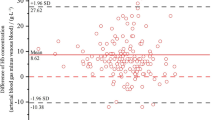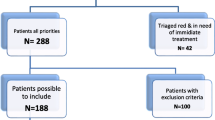Abstract
Objective : To compare pH and PCO2 values of simultaneously obtained arterial, arterialized capillary, and venous blood samples and also to compare oxygen saturation (ASaO2) measured in arterial blood and oxygen saturation by pulse oximetry (PSaO2).Methods: Prospective study was done in the children admitted in the Pediatric Intensive Care Unit of Christian Medical College Hospital Vellore, requiring critical care. All the three blood gas samples (arterial, capillary and venous) were taken simultaneously and analyzed. Oxygen saturation by pulse oximetry was also recorded.Results: 50 children aged 14 days to 12 years were included in the study. Arterial and capillary pH values were highly correlated (r2=0.9024, p < 0.0001). Out of 16 children with arterial acidosis 9(56%) were identified by capillary blood gas. Arterial and venous pH values also showed good correlation (r2=0.8449, p eric 0.0001). The PCO2 values of arterial and capillary blood gases were found to be highly correlated (r2=0.9534, p < 0.0001). The capillary blood gas accurately reflected the arterial PCO2 in 41 (82%) patients. Arterial and venous blood gas PCO2 values had less correlation (r2=0.5917, p=0.011). The arterial oxygen saturation (ASaO2) and oxygen saturation by pulse oximetry (PSaO2) were correlated moderately (r2=0.7241, p eric 0.0001).Conclusion: Even though arterial blood gas analysis is the gold standard, and when an arterial blood gas sample cannot be obtained, a combination of arterialized capillary blood gas and pulse oximetry can be effectively used in acutely ill children of all ages. Venous samples have a good correlation with arterial samples for pH but are not useful for monitoring blood gas status in acutely ill children.
Similar content being viewed by others
References
Sherry E, Courtney MD, Kaye R, Lee Aet al. Capillary blood gases in the neonate. A reassessment and review of the literature.Am J Dis Child 1990; 144:168–172.
Siggaard-Anderson O. Acid-base and blood gas parameters: arterial or capillary blood?Clin Lab Invest 1968; 21: 289–292.
Donner A, Eliasziw M. Sample size requirements for reliability studies.Statistics in Medicine 1987; 6: 441–448.
Landis JR, Koch GG. The measurement of observer agreement for categorical data.Biometrics 1977; 33:159–174.
Kama P, Poland R. Monitoring critically ill newborn infants with digital Capillary blood samples: an alternative.J Paediatr 1978; 92:270–273.
Desai SD, Holoway R, Thambiran AK, Wesley AG. A comparison between arterial and arterialized capillary blood in infant.S Afr Med J 1967; 41:13–15.
Glasgow JFT, Flynn DM, Swyen PR. A comparison of descending aortic and ‘arterialized’ capillary blood in the sick newborn.Can Med Assoc J 1972; 106: 660–662.
MacRae OJ, Palavradji O. Comparison between arterial, capillary and venous acid base measurements in the newborn infant.J Obstet Gynaecol Br Common w 1966; 75: 761–765.
Courtney SE, Kaye R, Breakie LAet al. Capillary blood gases in the neonate. A Reassessment and Review of the literature.Am J Dis Chi 1990; 144:168–172.
Gandy G, Grannl, Cunningham Net al. The validity of pH and PCO2 measurements in capillary samples in sick and healthy newborn infants.Pediatrics 1964; 34:192–197.
Harrison AM, Joanna M, Dean JMet al. Comparison of simultaneously obtained arterial and capillary blood gases in paediatric intensive care unit patients.Crit Care Med 1997; 25: 1904–1908.
Saili A, Dutta AK, Sarna MS. Reliability of capillary blood gas estimation in neonates.Indian Pediatr 1992; 29: 567–570.
Banister A. Comparison of arterial and arterialized capillary blood in infants with respiratory distress.Arch Dis Child 1969; 44:726–728.
Usher R. Discussion of complication arising from catheterization of umbilical vessels. In Lucey JF, ed.Problems of Neonatal Intensive Care. A report of the 59th Ross Conference on Paediatric Research. NewYork, NY: Columbus Press; 1969: 41–42.
Thomsen A. Arterial blood sampling in small infants.Ada Pediatr 1964; 53: 237–240.
Bland J, Altman D. Statistical methods for assessing agreement between two methods of clinical agreement.Lancet 1986; 1: 307–310.
Hunt CE. Capillary blood sampling in the infant: Usefulness and limitations of two methods of sampling, compared with arterial blood.Pediatrics 1973; 51: 501–506.
Koch G, Wendel H. Comparison of pH, CO2 tension, standard HCO3 and O2 tension in capillary blood and in arterial blood during the neonatal period.Ada Paediatr Scand 1967; 56:10–16.
Linderman J, Fahey TD, Lauten Get al. A comparison of blood gases and acid-base measurements in arterial, arterialized venous, and venous blood during short-term maximal exercise.Eur J Appl Physiol 1990; 61(3-4): 294–301.
Brandenburg MA, Dire DJ. Comparison of arterial and venous blood gas values in the initial emergency department, evaluation of patients with diabetic ketoacidosis.Ann Emerg Med 1998 Apr; 31(4): 459–465.
Ross Russel Ri, Helms PJet al. Comparative accuracy of pulse oximetry and transcutaneous oxygen in assessing arterial saturation in pediatric intensive care.Crit Care Med 1990; 18(7): 725–727.
Swedlow DB, Stern S. Continuous non-invasive oxygen saturation monitoring in children with a new pulse oximeter.Crit Care Med 1983; 12: 228–255.
Southall DP, Bignall S, Stebbens VA, Alexander JR, Rivers RP, Lissauer T. Pulse oximetry and transcutaneus arterial oxygen measurement in neonatal and pediatric intensive care.Arch Dis Chi 1987; 62(9): 882–888.
Author information
Authors and Affiliations
Corresponding author
Rights and permissions
About this article
Cite this article
Kirubakaran, C., Gnananayagam, J.E.J. & Sundaravalli, E.K. Comparison of blood gas values in arterial and venous blood. Indian J Pediatr 70, 781–785 (2003). https://doi.org/10.1007/BF02723794
Issue Date:
DOI: https://doi.org/10.1007/BF02723794




